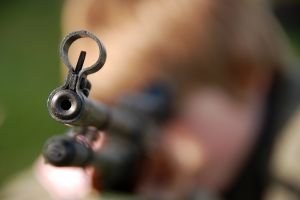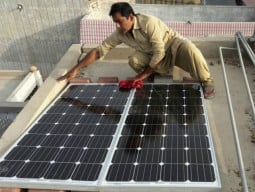
“I hoped to be there [at my school], but I had to grab a Kalashnikov and ammunition to take part in a conflict that erupted between our tribes,” says the 12-year-old student. A land dispute in Zaree Noor was the reason his marksmanship was called upon.
Children in FATA: How to stop the making of child soldiers

“There are so many issues, but I am determined to reclaim my white belt.” He adds the cloth, awarded to top position holders, was around his waist last year after the seventh grade exams.
A thirst for knowledge
While such armed conflicts do occur, militant presence, gunfire and bombs are no longer the dominant order of the day in South Waziristan. As a result, people are learning about the importance of education.
Wana, the main city, has seen a boom like no other. In other parts of the tribal region, parents pounce on the opportunity to send their children to a school if it opens up in their village. Well-established seats of learning are also limping back to life as the historic Musa Nika Public School is open to students once again. There has also been the establishment of Wana Cadet College to boost education.
Just three of the seven high schools in the area are functional. The situation is similar for middle schools as only a handful of the 27 are providing an education. At the same time, nearly 100 primary schools have been turned into guesthouses or cattle pens by tribal maliks. The only government degree college in Wana is also not properly functional.
Curbing harmful trends: ‘Toy guns promote acceptability of violence’
On paper
The paper trail of government schools may be long and stacked high, but ground realities tell a different tale.
“In Wana Bazaar, there is a guesthouse room where government schools’ registers are lying. They have details of teachers, students’ attendance records and even salaries. However, it seems all matters are dealt with here rather than inside school buildings,” shares Wana-based journalist Shahzaddin.
Changing trends
More boys in South Waziristan and their parents are leaning towards a modern education system rather than seminaries. As a result, enrolments in seminaries have seen a considerable decline.
However, while the boys are turning their attention towards contemporary schooling, more seminaries for girls are popping up. In 2000, a girls seminary in Wana taught about 3,000 students and there was little in the way of modern education in a school where students observed strict parda. Many other such institutes were also established in the tribal region.
While some of the narrative is changing for the better, some things remain the same – or perhaps are even taking a turn for the worse. Girls only study up to fifth grade and government schools for them exist in few villages. Even those institutes are only somewhat functional.
Hard hit by bombings, Islamic State is turning to child soldiers
The only fully functional girls government high school was in Dab Kot village, but it was blown up by militants and destroyed some years ago. It is one of the only villages where a fair share of the women are educated and even take part in voting during elections and other activities.
More carrot, less stick
There has also been a marked change in the approach of educators in South Waziristan. “I have to deal gently with such students. I have minimised the use of caning in my school – nearly ended the practice,” Junaid Khan, the young principal of Darvish Public High School says. He has an MPhil in Economics.
“I have to motivate them to attend school and study. They deserve to study,” he adds.
Sadly many institutes see the stick as a necessity in both government and private schools where students are frequently absent. Some take part in agricultural labour, others take up guns to embark on armed conflicts and there are even those who may have joined the ranks of the Taliban.
The bigger picture
It is perhaps too soon to expect all problems to be ironed out overnight. It is extremely encouraging that locals want to see a boost in education and some individuals have taken it upon themselves to establish schools. NGOs have also been working in the area and one of them, Wana Welfare Association, has been a major source of merit scholarships.
However, there is desperate need to re-empower women in the tribal agency. In the not too distant past, women were part of all the routine activity in an area rife with dance and culture. In fact, a popular form of entertainment was Baragai Attan, in which men and women would dance around a fire; interaction was not solely limited to blood relatives.
Teenage boy shoots girl, then himself on school premises
An elderly woman in the area, for example, will be hard pressed to remember people wearing burqas in her yesteryears. Nowadays, even little girls going to school are taught by a male teacher at a “safe” distance with a microphone and loudspeaker. Madrassatul Banat runs a parallel schooling system in which lessons are given to girls by a male teacher who sits in a separate room with a microphone.
The parda rewaj or use of veil is very much in place. Dr Maulana Taj Muhammad Wazir, head of Madrassatul Banat, points out there is a massive shortage of teachers and authorities have been asked to arrange for them.
Published in The Express Tribune, January 12th, 2016.

















1713904359-0/burn-(1)1713904359-0-270x192.webp)



















COMMENTS
Comments are moderated and generally will be posted if they are on-topic and not abusive.
For more information, please see our Comments FAQ